Case 1: Marble's popularity began in ancient Rome and Greece, where white and off-white marble were used to construct a variety of structures, from hand-held sculptures to massive pillars and buildings.
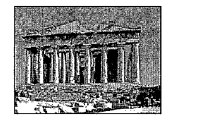
The substance not likely to contain is:
Dolomite
A marble statue
Calcined gypsum
Sea shells
The correct Answer is:D
Similar Questions
Marble’s popularity began in ancient Rome and Greece, where white and off-white marble were used to construct a variety of structures, from hand-held sculptures to massive pillars and buildings.
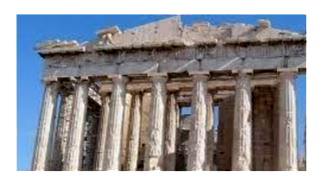
Gas A, obtained above is a reactant for a very important biochemical process which occurs in the presence of sunlight. Identify the name of the process
View SolutionMarble’s popularity began in ancient Rome and Greece, where white and off-white marble were used to construct a variety of structures, from hand-held sculptures to massive pillars and buildings.
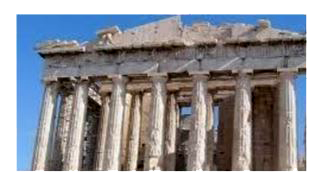
A student added 10g of calcium carbonate in a rigid container, secured it tightly and started to heat it. After some time, an increase in pressure was observed, the pressure reading was then noted at intervals of 5 mins and plotted against time, in a graph as shown below. During which time interval did maximum decomposition took place?
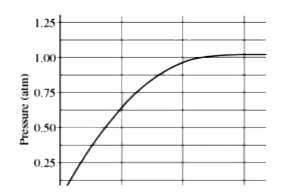
View Solution
Knowledge Check
Read the following and answer the question.
Marble's popularity began in ancient Rome and Greece, where white and off-white marble were used to construct a variety of structures, from hand held sculptures to massive pillars and buildings.

Gas A, obtained above is a reactant for a very important biochemical process which occurs in the presence of sunlight. Identify the name of the process -ARespirationBPhotosynthesisCTranspirationDPhotolysisNearly 6000 years ago, man took a giant step fonvard in his evolution on this earth when, giving up a nomadic type oflife, he took to agriculture. This memorable event happened in certain river valleys of India, China, Mesopotamia (modern Iraq) and Egypt. The reason was that the conditions in these areas were favourable for the cultivation of grains like wheat, rice etc because of plenty ofrich soil and water. Consequently, the farmer was able to produce more grains than he required for his needs. This helped in the development of settled cooperative living and. villages appeared where some people could make a living using some specialised skills or take up other jobs useful to the society instead of tilling the soil.
As time passed more and more families started living together for the sake of security against barbarians and wild animals. They built big buildings and cities sprang up. Such developments took place in many parts of the world where conditions were suitable for agriculture, trade and commerce. Since it was not hard to make a good living, men had spare time for the development of arts and crafts and engage in other activities which characterise a cultured life.
The ancient civilizations, though quite far removed from each other, did not develop in complete isolation. There was some trade and commerce accompanied at times by sharing of knowledge. It was not uncommon to have from time to time small or big wars and mass exodus of people for greener pastures. By 1000 BC, with considerable intermingling of races, several well-developed and prosperous civilisations had come into existence. Their borders of course were not well defined but kept on shifting due to wars. Here . we shall be concerned essentially with some of the fundamental contributions of the ancient Indian and Greek civilisations to human knowledge. One may like to know why these two could make more important and enduring contributions than other civilisations. The answer briefly is that by and large both in India and Greece · conditions for free, sober and intelligent thought were an integral part of the social structure. Furthermore, the philosophers were highly respected and they could without a care
Follow knowledge like a sinking star
Beyond the utmost bound of human thought.
To begin with, the philosophical developments in the two civilisations started along similar lines, with attempts to answer some basic questions like. Who am I? How was the world created? Is there life after death? And so on. This is not surprising since the forefathers ofthe Indo-Aryans and the Greeks lived together in Central Asia before mass migration. But in due course, around 500 BC, the effects of different environments and some in termixin u with other races began to have their effect and change in emphasi, in the pursuit of knowledge was noticeable. The Greeks, because of their rugged surrounding and contacts with other-seafaring people in trade and commerce, had to be practical. They turned more and more to the study and understanding of the 'outer world'. So successful were they in their endeavour and so basic were their contributions that it is now quite generally accepted that the entire modern intellectual education of the West, both philosophical and scientific, originates from the Greeks. The Indo-Aryans, on the other hand, once they had settled down comfortably in different parts oflndia did not have to fiice many challenges from the outside world. Consequently, they turned more and more towards religion and the study of man's 'inner world'. The degree of success and the mastery they achieved is best summed up by Schopenhauer, a German philosopher. Commenting about Upanishidic knowledge, he remarked,
"Thinking was finished on the banks ofriver Ganges."
Which step of man marks the end of his life as wanderers on this earth?Ahis taking up of jobs which were useful to the societyBhis shift towards agricultural activitiesCdevelopment-of the sense of brotherhoodDevolution oftrade and commerceNearly 6000 years ago, man took a giant step fonvard in his evolution on this earth when, giving up a nomadic type oflife, he took to agriculture. This memorable event happened in certain river valleys of India, China, Mesopotamia (modern Iraq) and Egypt. The reason was that the conditions in these areas were favourable for the cultivation of grains like wheat, rice etc because of plenty ofrich soil and water. Consequently, the farmer was able to produce more grains than he required for his needs. This helped in the development of settled cooperative living and. villages appeared where some people could make a living using some specialised skills or take up other jobs useful to the society instead of tilling the soil.
As time passed more and more families started living together for the sake of security against barbarians and wild animals. They built big buildings and cities sprang up. Such developments took place in many parts of the world where conditions were suitable for agriculture, trade and commerce. Since it was not hard to make a good living, men had spare time for the development of arts and crafts and engage in other activities which characterise a cultured life.
The ancient civilizations, though quite far removed from each other, did not develop in complete isolation. There was some trade and commerce accompanied at times by sharing of knowledge. It was not uncommon to have from time to time small or big wars and mass exodus of people for greener pastures. By 1000 BC, with considerable intermingling of races, several well-developed and prosperous civilisations had come into existence. Their borders of course were not well defined but kept on shifting due to wars. Here . we shall be concerned essentially with some of the fundamental contributions of the ancient Indian and Greek civilisations to human knowledge. One may like to know why these two could make more important and enduring contributions than other civilisations. The answer briefly is that by and large both in India and Greece · conditions for free, sober and intelligent thought were an integral part of the social structure. Furthermore, the philosophers were highly respected and they could without a care
Follow knowledge like a sinking star
Beyond the utmost bound of human thought.
To begin with, the philosophical developments in the two civilisations started along similar lines, with attempts to answer some basic questions like. Who am I? How was the world created? Is there life after death? And so on. This is not surprising since the forefathers ofthe Indo-Aryans and the Greeks lived together in Central Asia before mass migration. But in due course, around 500 BC, the effects of different environments and some in termixin u with other races began to have their effect and change in emphasi, in the pursuit of knowledge was noticeable. The Greeks, because of their rugged surrounding and contacts with other-seafaring people in trade and commerce, had to be practical. They turned more and more to the study and understanding of the 'outer world'. So successful were they in their endeavour and so basic were their contributions that it is now quite generally accepted that the entire modern intellectual education of the West, both philosophical and scientific, originates from the Greeks. The Indo-Aryans, on the other hand, once they had settled down comfortably in different parts oflndia did not have to fiice many challenges from the outside world. Consequently, they turned more and more towards religion and the study of man's 'inner world'. The degree of success and the mastery they achieved is best summed up by Schopenhauer, a German philosopher. Commenting about Upanishidic knowledge, he remarked,
"Thinking was finished on the banks ofriver Ganges."
Development of villages became easy becauseApeople gave up agriculture and took to alternate jobs.Ba sense of security led people to live in units like villages.Cpeople were fed up ofnomadic lifestyle.DNone of these
Marble’s popularity began in ancient Rome and Greece, where white and off-white marble were used to construct a variety of structures, from hand-held sculptures to massive pillars and buildings.
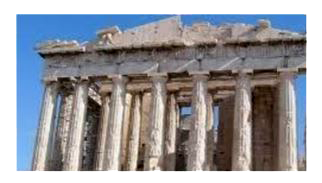
Marble statues are corroded or stained rain water. Identify the main reason
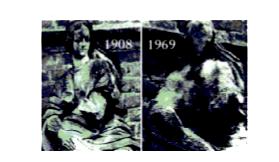
View SolutionMarble’s popularity began in ancient Rome and Greece, where white and off-white marble were used to construct a variety of structures, from hand-held sculptures to massive pillars and buildings.
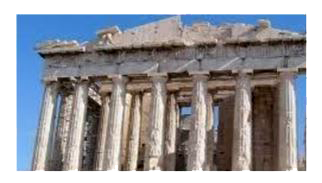
Calcium oxide can be reduced to calcium, by heating with sodium metal. Which compound would act as an oxidizing agent in the above process
View SolutionNearly 6000 years ago, man took a giant step fonvard in his evolution on this earth when, giving up a nomadic type oflife, he took to agriculture. This memorable event happened in certain river valleys of India, China, Mesopotamia (modern Iraq) and Egypt. The reason was that the conditions in these areas were favourable for the cultivation of grains like wheat, rice etc because of plenty ofrich soil and water. Consequently, the farmer was able to produce more grains than he required for his needs. This helped in the development of settled cooperative living and. villages appeared where some people could make a living using some specialised skills or take up other jobs useful to the society instead of tilling the soil.
As time passed more and more families started living together for the sake of security against barbarians and wild animals. They built big buildings and cities sprang up. Such developments took place in many parts of the world where conditions were suitable for agriculture, trade and commerce. Since it was not hard to make a good living, men had spare time for the development of arts and crafts and engage in other activities which characterise a cultured life.
The ancient civilizations, though quite far removed from each other, did not develop in complete isolation. There was some trade and commerce accompanied at times by sharing of knowledge. It was not uncommon to have from time to time small or big wars and mass exodus of people for greener pastures. By 1000 BC, with considerable intermingling of races, several well-developed and prosperous civilisations had come into existence. Their borders of course were not well defined but kept on shifting due to wars. Here . we shall be concerned essentially with some of the fundamental contributions of the ancient Indian and Greek civilisations to human knowledge. One may like to know why these two could make more important and enduring contributions than other civilisations. The answer briefly is that by and large both in India and Greece · conditions for free, sober and intelligent thought were an integral part of the social structure. Furthermore, the philosophers were highly respected and they could without a care
Follow knowledge like a sinking star
Beyond the utmost bound of human thought.
To begin with, the philosophical developments in the two civilisations started along similar lines, with attempts to answer some basic questions like. Who am I? How was the world created? Is there life after death? And so on. This is not surprising since the forefathers ofthe Indo-Aryans and the Greeks lived together in Central Asia before mass migration. But in due course, around 500 BC, the effects of different environments and some in termixin u with other races began to have their effect and change in emphasi, in the pursuit of knowledge was noticeable. The Greeks, because of their rugged surrounding and contacts with other-seafaring people in trade and commerce, had to be practical. They turned more and more to the study and understanding of the 'outer world'. So successful were they in their endeavour and so basic were their contributions that it is now quite generally accepted that the entire modern intellectual education of the West, both philosophical and scientific, originates from the Greeks. The Indo-Aryans, on the other hand, once they had settled down comfortably in different parts oflndia did not have to fiice many challenges from the outside world. Consequently, they turned more and more towards religion and the study of man's 'inner world'. The degree of success and the mastery they achieved is best summed up by Schopenhauer, a German philosopher. Commenting about Upanishidic knowledge, he remarked,
"Thinking was finished on the banks ofriver Ganges."
Which of the following is true in the context of the passage?
View SolutionNearly 6000 years ago, man took a giant step fonvard in his evolution on this earth when, giving up a nomadic type oflife, he took to agriculture. This memorable event happened in certain river valleys of India, China, Mesopotamia (modern Iraq) and Egypt. The reason was that the conditions in these areas were favourable for the cultivation of grains like wheat, rice etc because of plenty ofrich soil and water. Consequently, the farmer was able to produce more grains than he required for his needs. This helped in the development of settled cooperative living and. villages appeared where some people could make a living using some specialised skills or take up other jobs useful to the society instead of tilling the soil.
As time passed more and more families started living together for the sake of security against barbarians and wild animals. They built big buildings and cities sprang up. Such developments took place in many parts of the world where conditions were suitable for agriculture, trade and commerce. Since it was not hard to make a good living, men had spare time for the development of arts and crafts and engage in other activities which characterise a cultured life.
The ancient civilizations, though quite far removed from each other, did not develop in complete isolation. There was some trade and commerce accompanied at times by sharing of knowledge. It was not uncommon to have from time to time small or big wars and mass exodus of people for greener pastures. By 1000 BC, with considerable intermingling of races, several well-developed and prosperous civilisations had come into existence. Their borders of course were not well defined but kept on shifting due to wars. Here . we shall be concerned essentially with some of the fundamental contributions of the ancient Indian and Greek civilisations to human knowledge. One may like to know why these two could make more important and enduring contributions than other civilisations. The answer briefly is that by and large both in India and Greece · conditions for free, sober and intelligent thought were an integral part of the social structure. Furthermore, the philosophers were highly respected and they could without a care
Follow knowledge like a sinking star
Beyond the utmost bound of human thought.
To begin with, the philosophical developments in the two civilisations started along similar lines, with attempts to answer some basic questions like. Who am I? How was the world created? Is there life after death? And so on. This is not surprising since the forefathers ofthe Indo-Aryans and the Greeks lived together in Central Asia before mass migration. But in due course, around 500 BC, the effects of different environments and some in termixin u with other races began to have their effect and change in emphasi, in the pursuit of knowledge was noticeable. The Greeks, because of their rugged surrounding and contacts with other-seafaring people in trade and commerce, had to be practical. They turned more and more to the study and understanding of the 'outer world'. So successful were they in their endeavour and so basic were their contributions that it is now quite generally accepted that the entire modern intellectual education of the West, both philosophical and scientific, originates from the Greeks. The Indo-Aryans, on the other hand, once they had settled down comfortably in different parts oflndia did not have to fiice many challenges from the outside world. Consequently, they turned more and more towards religion and the study of man's 'inner world'. The degree of success and the mastery they achieved is best summed up by Schopenhauer, a German philosopher. Commenting about Upanishidic knowledge, he remarked,
"Thinking was finished on the banks ofriver Ganges."
What led to the development of farming in India, China, Mesopotamia and Iraq?
View SolutionNearly 6000 years ago, man took a giant step fonvard in his evolution on this earth when, giving up a nomadic type oflife, he took to agriculture. This memorable event happened in certain river valleys of India, China, Mesopotamia (modern Iraq) and Egypt. The reason was that the conditions in these areas were favourable for the cultivation of grains like wheat, rice etc because of plenty ofrich soil and water. Consequently, the farmer was able to produce more grains than he required for his needs. This helped in the development of settled cooperative living and. villages appeared where some people could make a living using some specialised skills or take up other jobs useful to the society instead of tilling the soil.
As time passed more and more families started living together for the sake of security against barbarians and wild animals. They built big buildings and cities sprang up. Such developments took place in many parts of the world where conditions were suitable for agriculture, trade and commerce. Since it was not hard to make a good living, men had spare time for the development of arts and crafts and engage in other activities which characterise a cultured life.
The ancient civilizations, though quite far removed from each other, did not develop in complete isolation. There was some trade and commerce accompanied at times by sharing of knowledge. It was not uncommon to have from time to time small or big wars and mass exodus of people for greener pastures. By 1000 BC, with considerable intermingling of races, several well-developed and prosperous civilisations had come into existence. Their borders of course were not well defined but kept on shifting due to wars. Here . we shall be concerned essentially with some of the fundamental contributions of the ancient Indian and Greek civilisations to human knowledge. One may like to know why these two could make more important and enduring contributions than other civilisations. The answer briefly is that by and large both in India and Greece · conditions for free, sober and intelligent thought were an integral part of the social structure. Furthermore, the philosophers were highly respected and they could without a care
Follow knowledge like a sinking star
Beyond the utmost bound of human thought.
To begin with, the philosophical developments in the two civilisations started along similar lines, with attempts to answer some basic questions like. Who am I? How was the world created? Is there life after death? And so on. This is not surprising since the forefathers ofthe Indo-Aryans and the Greeks lived together in Central Asia before mass migration. But in due course, around 500 BC, the effects of different environments and some in termixin u with other races began to have their effect and change in emphasi, in the pursuit of knowledge was noticeable. The Greeks, because of their rugged surrounding and contacts with other-seafaring people in trade and commerce, had to be practical. They turned more and more to the study and understanding of the 'outer world'. So successful were they in their endeavour and so basic were their contributions that it is now quite generally accepted that the entire modern intellectual education of the West, both philosophical and scientific, originates from the Greeks. The Indo-Aryans, on the other hand, once they had settled down comfortably in different parts oflndia did not have to fiice many challenges from the outside world. Consequently, they turned more and more towards religion and the study of man's 'inner world'. The degree of success and the mastery they achieved is best summed up by Schopenhauer, a German philosopher. Commenting about Upanishidic knowledge, he remarked,
"Thinking was finished on the banks ofriver Ganges."
The Indo-Aryans with a religious bent of mind turned to the study of man's inner world because
View Solution
